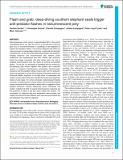Flash and grab : deep-diving southern elephant seals trigger anti-predator flashes in bioluminescent prey
Abstract
Bioluminescence, which occurs in approximately 80% of the world's mesopelagic fauna, can take the form of a low-intensity continuous glow (e.g. for counter-illumination or signalling) or fast repetitions of brighter anti-predatory flashes. The southern elephant seal (SES) is a major consumer of mesopelagic organisms, in particular the abundant myctophid fish, yet the fine-scale relationship between this predator's foraging behaviour and bioluminescent prey remains poorly understood. We hypothesised that brief, intense light emissions should be closely connected with prey strikes when the seal is targeting bioluminescent prey that reacts by emitting anti-predator flashes. To test this, we developed a biologging device containing a fast-sampling light sensor together with location and movement sensors to measure simultaneously anti-predator bioluminescent emissions and the predator's attack motions with a 20 ms resolution. Tags were deployed on female SES breeding at Kerguelen Islands and Península Valdés, Argentina. In situ light levels in combination with duration of prey capture attempts indicated that seals were targeting a variety of prey types. For some individuals, bioluminescent flashes occurred in a large proportion of prey strikes, with the timing of flashes closely connected with the predator's attack motion, suggestive of anti-predator emissions. Marked differences across individuals and location indicate that SES do exploit bioluminescent organisms but the proportion of these in the diet varies widely with location. The combination of wideband light and acceleration data provides new insight into where and when different prey types are encountered and how effectively they might be captured.
Citation
Goulet , P , Guinet , C , Campagna , C , Campagna , J , Tyack , P L & Johnson , M 2020 , ' Flash and grab : deep-diving southern elephant seals trigger anti-predator flashes in bioluminescent prey ' , Journal of Experimental Biology , vol. 223 , no. 10 , jeb.222810 . https://doi.org/10.1242/jeb.222810
Publication
Journal of Experimental Biology
Status
Peer reviewed
ISSN
0022-0949Type
Journal article
Description
Funding: Fondation BNP Paribas; Centre National d'Etudes Spatiales; Institut Polaire Français Paul Emile Victor; Natural Environment Research Council; H2020 Marie Skłodowska-Curie Actions.Collections
Items in the St Andrews Research Repository are protected by copyright, with all rights reserved, unless otherwise indicated.

